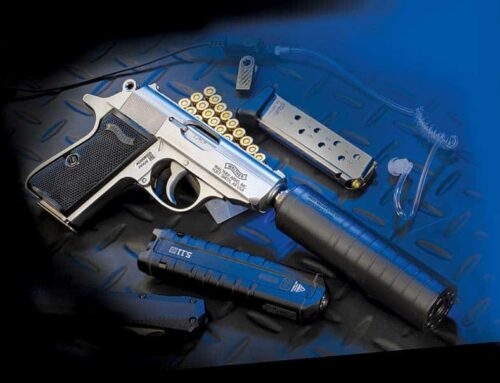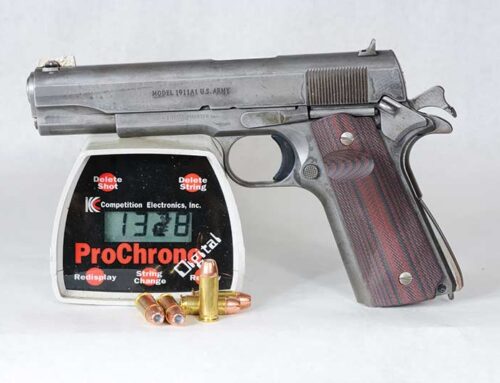The .40 Smith & Wesson cartridge has been called many things since it was introduced in 1990.
Winchester Supreme Elite PDX1 40 S&W 165 grainSlow & Weak
Save your bacon & Walk free
Sexy & Winchester
Shoot & Wound
Sledgehammer & Wallop
Shortened & Widened
Sluggish & Wimpy
Slay & Waste
Studious & Well-spoken
Oh yeah, and Smith & Wesson…
Used by the majority of law enforcement organizations, the .40 S&W round has somehow managed to gain flocks of proponents and many vocal detractors. One thing we’ve found in our testing is that broad caliber generalizations are absolutely meaningless. Everything depends on the specific projectile and load being tested with any given caliber.
Let’s take a closer look at the Winchester Supreme Elite PDX1 Defender ammunition in .40 S&W 165 grain loading.
Winchester Supreme Elite PDX1 Defender .40 S&W 165 Grain Ammunition Overview
Winchester PDX1 ammunition is a bonded hollow point design. In average Joe’s English, that simply means that the jacket of the bullet is chemically attached to the lead core interior. Speer Gold Dot ammunition uses a similar design process.
Why?
Winchester believes that a bonded design allows more control over the delicate balance between penetration and expansion – without risk of jacket separation that is prone to occur with traditional jacketed / lead core bullets. The Winchester PDX1 round is pre-programmed by shape and cuts to expand into six segments as the projectile expands.
165 grain .40 S&W: Feel the need for speed…
We clocked a veritable pile of the Winchester PDX1 Elite .40 S&W 165 grain ammo through our Shooting Chrony Beta Master, placed 15 feet down range. When all was averaged out using some complex addition and division with a touch of calculus, we found that the PDX1 ammo achieved average velocity of 1,195 feet per second. Factory specs listed on the box claim 1,140 feet per second at the muzzle, so this round outperformed the claims in our evaluation.
The test gun for the velocity test was a Beretta PX4 Storm full size – we did a full gun review on this one a while back. This particular handgun features a 4 inch barrel, so we’re not getting the full velocity advantage of an extra inch on a longer barreled pistol – and the round still outperformed the velocity claim.
Why?
Could be a number of factors. Perhaps the claimed velocity is a conservative number. We’ve seen that before and we always welcome conservative marketing claims – it’s a pleasant surprise when your ammunition performs even better than expected. Or perhaps our testing is done in a higher temperature environment. We’re in South Cackalackee where weather conditions are generally 90/90/90. That’s 90 degrees, 90 percent humidity, and 90 times hotter than it should be. The hotter it is, the higher the pressure, and higher the measured velocity.
Winchester PDX1 ammo expansion performance
Expansion performance of the Winchester PDX1 was excellent – most rounds doubled in diameter.Our expansion testing always considers performance through barriers. Any reasonable ammo will expand in picture perfect manner when shot into water or gelatin. It’s like reality TV. Real, but not really. Many fail however when you place the water or gelatin backstop behind real world barriers like clothing. Not too many thugs run around buck naked as far as we know, so we’d rather see how our carry ammunition performs against clothed attackers.
For the Winchester PDX1 Defender tests, we used a barrier consisting of 2 layers of light canvas and 2 layers of cotton fabric. We’ve settled on this combination to provide an average “clothing” simulation for average weather conditions. We’ve found that many brand name hollow points have failed to perform consistently behind even this relatively simple barrier. Some rounds will expand while others will clog with fabric and behave like full metal jacket ammunition – passing right through the target. Behind the fabric barrier, we used simple wet pack. That’s just thoroughly soaked newsprint.
We obtained excellent results with this particular Winchester PDX1 ammo. The extra velocity available with the 165 grain load made a noticeable difference in expansion performance. The packaging claims 1.5x expansion capability. In our tests, we found that projectiles expanded to over .6 inches in diameter easily, with many rounds doubling in diameter. Performance of the programmed petal expansion was consistent as well with all six petals expanding in nearly every case.
Closing arguments
This particular Winchester PDX1 ammunition performed in stellar fashion. As mentioned at the beginning of this article, it’s important to look at each specific loading independently as performance may vary. We’ll be testing the heavier, but slower, 180 grain Winchester PDX1 ammo as well and will report on that separately. Considering that this test was done with a Beretta PX4 Storm with average barrel length, we highly recommend this round for mid size to full size handguns. We’ll try to test it in a short barrel .40 S&W handgun to see how it fares.
Our Rating
 |
Four Nuns! Velocity was better than advertised through an average length barrel and expansion performance through moderate fabric barriers was excellent. What more can you ask? |








You missed “Short & Weak”. When it first appeared it was compared to the full load 10mm and should have been compared to its inspiration, the Remington .45 ACP +P 185 gr HP.
Good evaluation and I like your protocols. Keep up the good work.
“This particular Winchester PDX1 ammunition performed in stellar fashion.”
—Yes, LITERALLY!!
I’ve been using PDX1 for a while now in 9mm. Good to know it’s also a great .40 option.
[…] Ammo Review: Winchester PDX1 Elite Defender.40. – The.40 Smith & Wesson cartridge has been called many things since it was introduced in 1990. Slow & Weak Save your bacon & Walk free Sexy & Winchester. […]
[…] Ammo Review: Winchester PDX1 Elite Defender.40. – The.40 Smith & Wesson cartridge has been called many things since it was introduced in 1990. Slow & Weak Save your bacon & Walk free Sexy & Winchester. […]